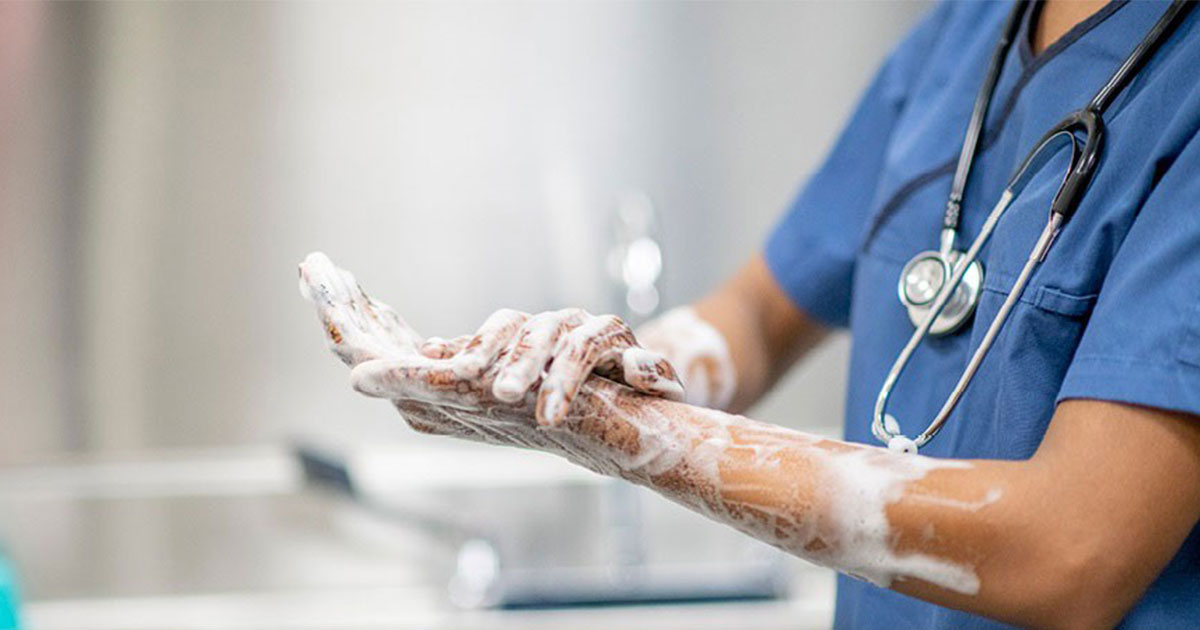Beyond COVID-19: Resetting infection prevention priorities

Leadership, education and a return to standard protocols are keys to reversing the rise in HAIs and other infections
By Medline Newsroom Staff | March 9, 2022
Two years ago, the pandemic upended and reprioritized infection prevention protocols at hospitals and other healthcare facilities throughout the U.S. Since then, non-COVID-19 infections are on the rise, with a recent report of the Centers for Disease Control and Prevention (CDC) finding “significant increases” in healthcare-associated infections (HAIs) in 2020 over 2019, including central line-associated bloodstream infections (CLABSIs), catheter-associated urinary tract infections (CAUTIs), ventilator-associated events (VAEs) and methicillin-resistant Staphylococcus aureus (MRSA) bacteria. More recently, Candida auris, a potentially deadly fungal disease resistant to treatment and disinfection, was identified in Louisiana less than a month after cases were reported in Oregon.
The CDC report attributes the surge to a move away from infection prevention best practices during COVID-19, as well as resource and staffing constraints.
“The biggest infection prevention challenge right now is staffing,” said Donna Matocha, DNP, MSN, Medline manager of clinical resources. “This includes the staffing of caregivers as well as the turnover rate of infection preventionists. If you have limited staff, things are going to fall through the cracks because you just don’t have the bandwidth to get everything done the way that it needs to be done.”
The findings highlight the need for education and training, a return to basic infection prevention protocols, and effective, informed and non-punitive leadership across the continuum of care.
Back to the basics
“Hand hygiene is huge, and it’s been demonstrated in the literature over and over again as an effective way to stop the spread of infection,” said Matocha. “No matter what disease or infectious process that we’re dealing with, this holds true.”
Matocha said that hospitals had not reached full hand hygiene compliance prior to the pandemic. “And given that all infections have risen during the pandemic, I think that encouraging and pushing for appropriate hand hygiene is an easy way to start driving down infections.”
Jerry Neal, administrator of Sunset Senior Living in Quincy, Illinois, agrees and said that a continued emphasis on the basics – “proper use of PPE, hand washing and all of the other more common policies” – are resulting in fewer infections at his long-term care facility. “The use of private rooms to isolate, and the use of HEPA filtration units for air purification are some of the other things that have helped.”
Leading by example
To reset infection protocols and compliance, Matocha recommends reevaluating current practices and “building a multidisciplinary, collaborative team of leaders” who can serve as “facility champions” for the prevention of CLABSI, CAUTI and other infections.
“Infection control is everybody’s responsibility,” said Neal. “Prior to COVID-19, it was generally thought that this was only a nursing and housekeeping responsibility. Now we know and understand that this touches every department and every employee.
“Leadership from the top down is important to ensure compliance, and leading by example is the best way to do it,” said Neal. “If frontline staff see the administrator, director of nursing or charge nurses skimping on infection prevention protocols, they won’t take it seriously either. These leaders are more present on the units to ensure that infection prevention protocols are adhered to. In addition, in-services, signage reminders and infection compliance rounds by supervisors can be constant reminders to staff to pay attention.”
Matocha says that maintaining a non-punitive culture that is open to reporting mistakes is also essential to ensuring ongoing attention to infection prevention protocols.
“You never want to have a culture that is punitive to staff,” said Matocha. “We know that a lot of time what we see in the reporting is lower than what is occurring. If you don’t know that those mistakes are occurring, then you can’t even begin to develop a ‘just culture,’ which takes those mistakes, evaluates them and then determines if a process or policy needs to be changed to prevent that mistake from recurring.’”
Education and training
With HAIs and other infections on the rise in healthcare facilities, the U.S. Centers for Medicare & Medicaid Services (CMS) are increasing and incentivizing infection prevention compliance.
“It is obvious that CMS is making this a priority for compliance, and facilities must too, not just for regulatory compliance, but for the safety of the seniors we serve,” said Neal. “Start by making sure you are providing the proper education and training to new and current staff on infection prevention policies and protocols. Make sure you are providing them with all of the necessary products and tools to comply, and then hold them accountable through infection prevention rounds and inspections.”
While infection preventionists typically have other primary responsibilities, both Neal and Matocha said it’s important that they stay on top of evolving CDC, CMS and Association for Professionals in Infection Control and Epidemiology (APIC) regulations.
“The infection preventionist develops and updates policies and procedures to comply with these changes,” said Neal. In addition, the infection preventionist alerts staff when “updated policies and procedures are available for their review and acknowledgement,” and provides one-on-one training as necessary.
Matocha said it is imperative that leadership “encourage and support” ongoing infection preventionist training and APIC Certification in Infection Control (CIC) “to improve outcomes as well as retention of staff.”
Preparing for the next pandemic
While the pandemic may soon become an endemic, healthcare providers must continue to prepare for the next significant infection challenge.
“We know that this isn’t going to be the last thing,” said Matocha. “We know that we need to be ready for the next round of diseases, which I believe are going to be fungal, and there are not a lot of antibiotics to treat them.”
“No one saw this pandemic coming,” said Neal, “and as a nation, a profession and at the facility level, we were caught off guard and unprepared for it. We can’t allow that to happen again. There will be other strains and other variants, and each one will present its own challenge. We must take what we’ve learned over the past couple of years and apply these lessons. We must learn that prolonged isolation is not the best way to care for our seniors. We must use technology in our physical plants to allow for proper ventilation. We must continue to emphasize all the infection prevention practices we have learned, be prepared with sufficient supplies of PPE necessary to stay safe and protect our seniors, and most of all, remember the consequences if we fail to do this, as we remember the lives lost to this terrible virus.”
Learn more about how Medline helps fight the spread of infection across the continuum of care.
Medline Newsroom Staff
Medline Newsroom Staff
Medline's newsroom staff researches and reports on the latest news and trends in healthcare.

